The body of 57-year-old Tibetan Buddhist leader Hungkar Dorje (aka Trulku Hungkar Dorje, Hungkar Dorje Rinpoche) was cremated under darkness at 1am on 20 April 2025, in a highly secretive and tightly controlled ceremony in Ho Chi Minh City, Vietnam, according to information from sources who have been keeping in contact with people close to him. Approximately 40 Vietnamese police officers and around 30 Chinese officials were deployed to ensure that the cremation proceeded according to plan, according to the sources. Cameras and all forms of recording devices were strictly prohibited at the cremation site to prevent transparency.
The highly respected Tibetan religious and cultural leader had passed away in Ho Chi Minh City, Vietnam, on 28 March 2025. Chinese authorities informed his monastery, Lung-ngon Monastery in Gade (Gande) County, Golog (Guoluo) Tibetan Autonomous Prefecture, of his death, though his status had remained a mystery since his inaccessibility to his students and well-wishers from July 2024 onwards. Lung-ngon monastery issued a seemingly coerced statement dated April 3 claiming that Trulku Hungkar Dorjee had quietly left for a retreat last year. However, Tibetan followers have rejected the Chinese authorities’ narrative issued via the monastery’s leadership.
The International Campaign for Tibet is deeply concerned about the death and the rushed cremation of Hungkar Dorje, as circumstances point to an implication of the Chinese authorities in the passing away of this highly respected Tibetan Buddhist leader. We have seen a pattern of Tibetan Buddhist leaders of their respective communities in Tibet became targets of Chinese state persecution. Some of them passed away in Chinese custody under unresolved circumstances, such as Tenzin Delek Rinpoche, or were sentenced to long prison sentences such as the Bangri Rinpoche. ICT calls on the international community to raise the case of Hungkar Dorje directly with the Chinese and the Vietnamese governments and condemn the circumstances of his rushed cremation.
The preceding circumstances surrounding the Tibetan lama’s death and the secretive cremation has raised significant concerns. First, his body was not returned to his homeland and his monastery as requested by a team of monks from his monastery (Lung-ngon Thubten Chokhorling) who had arrived to collect the body for traditional funeral rites in Tibet. Second, the Chinese diplomatic mission in Vietnam was heavily involved, with numerous Chinese officials representing various departments and levels of the Chinese government in Tibet arrived in Vietnam to control the issue, the activities of the monks in an apparent attempt of intimidation, representing an element of the Chinese government’s transnational repression in Vietnam. Third, throughout the process, the team of monks from the lama’s monastery were not given direct contact with the Vietnamese authorities and the Chinese government team in Vietnam took direct charge of the matter.
Even the immediate cause of death and date of death is highly suspicious. The Chinese officials’ first communication to Hungkar Dorje Rinpoche’s monastery cited that he had died in Vietnam of a heart attack. However, he never had a medical history of heart disease according to Tibetans close to him. The Chinese government told his monastery that he died on March 29 in Vietnam which the monastery’s announcement of his death also cited it as the date of the death. But our sources suspect that the change in date is a deliberate cover-up of the events leading to his death in the following timeline.
Vietnamese authorities encountered Hungkar Dorje Rinpoche in a hotel on March 25, our sources said. He was detained in the hotel for the following two days. On March 28, Vietnamese police moved him away from the hotel to a what could have been a police facility where he is believed to have died the same day in custody. Thereafter, sources believe that his body was moved to Vinmec Central Park International Hospital with the intent to make it appear as if he died there. But even before the Chinese authorities’ first communication to the monastery on April 1, informing the monks about Rinpoche’s death, sources said the Vietnamese authorities had approached a Buddhist religious center in Ho Chi Minh City asking about whether the center knew Hungkar Dorje who had died on March 28 indicating that he had died on March 28 and not on March 29.
The key detail about how Hungkar Dorje Rinpoche landed in Vietnam is still not officially established. The Vietnamese authorities have not released any details about the port of entry, date and the document under which he entered Vietnam. This detail is critical as it can help establish the reasons for his travel there, including whether he was in Vietnam to escape from Chinese persecution or not. Sources believe he fled to Vietnam to escape from the Chinese persecution. Vietnam requires a passport to enter the country on e-visa, visa-on-arrival or no visa entries to the country. Our sources say that Golog prefecture authority is in possession of Hungkar Dorje Rinpoche’s passport as Tibetan religious leaders must get their passport from the authority and return it upon returning from foreign countries. In the event of Hungkar Dorje Rinpoche being in Vietnam without a passport, it would be an indication that he was escaping from the People’s Republic of China. Then, the chain of events indicates transnational repression by China to seek him out in a foreign territory. Our sources said Hungkar Dorje Rinpoche has been facing escalating harassment and abuses since June 2024 when he did not comply with the Chinese authority’s order to provide an elaborate welcome to the Chinese government installed Panchen Lama’s government organized tour to his hometown. Chinese state media on 24 September 2024, reported that a large delegation of Chinese government officials met with Hungkar Dorje Rinpoche at the monastery to learn “in detail about Lung-ngon monastery’s work in monastery management, intangible cultural heritage protection, and efforts to forge a strong sense of community for the Chinese nation.” State media reported the government delegation of telling Hungkar Dorje and the monastery leadership that “In future work, religious figures should continue to thoroughly study and implement General Secretary Xi Jinping’s important statements on religious work, fully and accurately understand the Party’s religious work theories and policies in the new era, uphold the direction of the Sinicization of religion in China, actively promote the patriotic and religious traditions of Tibetan Buddhism, resolutely support the leadership of the Communist Party of China and the socialist system, safeguard national unity and security, promote religious harmony, social stability, and ethnic unity, and play an active role in the process of Chinese-style modernization.” Peeling off the layers of standard state propagandistic language, the state media reporting indicates that Hungkar Dorje Rinpoche was under immense pressure from the Chinese government.
Chronological chain of events
- 25 March: Vietnamese authorities encountered Hungkar Dorje in a hotel. Detained him in the hotel on 26-27 March.
- 28 March: Moved away from the hotel and believed to have died on the same day.
- 1 April: The Chinese government informed Lung-ngon Thubten Chokhorling monastery about Hungkar Dorje’s death on 29 March.
- 3 April: Lung-ngon monastery in its announcement of Hungkar’s death cites 29 March as the date of death.
- 5 April: Five Lung-ngon monastery monks and six Chinese officials arrived in Ho Chi Minh City, Vietnam, in the morning to collect Hungkar Dorje’s body for funeral rites in Tibet. Hungkar’s nephew (also a monk at Lung-ngon Monastery) was one of the five monks who arrived in Vietnam. The six Chinese officials had representation from Golog prefecture security, Qinghai province state security and Gade county’s United Front Work Department and Religion bureau. While in Ho Chi Minh City, the monks were told to sign a document stating that Hungkar Dorje Rinpoche had died and were told to return to Tibet. The monks refused to sign the document without seeing the body.
- 10 April: The five monks, divided into subgroups, were allowed to see Rinpoche’s face briefly for a couple of minutes at the Vinmec Central Park International Hospital. The body was covered in white sheet.
- 14 April: Xi Jinping’s state visit to Vietnam as part of his south-east Asia tour to strengthen ties with neighboring countries amid an escalating trade war with the United States.
- 18 April: Hungkar Dorje’s body moved to a nearby cemetery in the compound of a Sakya Buddhist temple, from Vinmec Central Park International Hospital around 11pm. The personal phones of the five monks from Tibet and the Vietnamese followers were seized. It is estimated that around 40 Vietnamese policemen and 30 Chinese officials were deployed to ensure maintenance of low profile of the cremation with no documentation on all forms of recording devices.
- 20 April: Hungkar Dorje Rinpoche cremated amidst tight control in the middle of the night around 1 am.
Hungkar Dorje Rinpoche’s religious and social activities
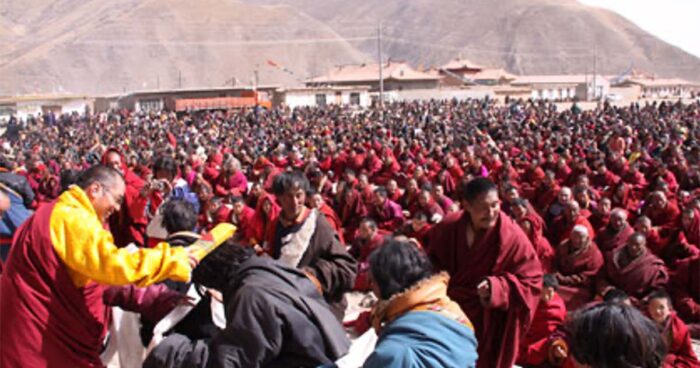
A large gathering of Tibetan devotees receiving Hungkar Dorje’s teachings on a pleasant day in Golog. (undated photo)
Hungkar Dorje Rinpoche was born on 15 August 1967 to a nomadic family in Golog, traditional Tibet’s Amdo region now incorporated into China’s administrative division of Qinghai province.
In early 2000, he took charge of various activities of Lung-ngon Thubten Chokhorling monastery founded by a prominent Lama, Do Khyentse Yeshe Dorje (1800-1866). The monastery with its humble beginning as a roving monastery housed in a nomadic yak hair tent, grew into its current form in 1980, built by his father Orgyen Kusum Lingpa popularly known as Lama Sang (1934-2009), during China’s relatively lenient period of religious policy after the cultural revolution. The monastery was officially registered and recognized by the Chinese government.
Since taking over leadership, Hungkar Dorje Rinpoche engaged in numerous social and religious activities in his hometown and across the world where he has a large following who are predominantly from the Vietnamese diaspora community. As a philanthropist and educator, he founded the Dharma Institute, a nine-year Buddhism training program for lay people. He also founded the Gesar Shenpen Foundation, the Mayul Center of Studies, and the Tibetan School for Traditional and Modern Education. He built a vocational school in Golog to provide free education for the Tibetans in the region. Sharing his experience on his personal website HungkarDorje.org, he states, “Because I was not able to go to school when I was a child, I still felt there was something missing; I would feel fulfilled only if I could provide young people with the opportunity to study. With the goal of giving young people a brighter future, I spent a number of years working to establish a school where pupils learn languages, writing, and vocational skills. The teachers at the school nurture the pupils with pure motivation and hard work, giving them a high-quality education with excellent results and the school has gradually become seen throughout Tibet as a praiseworthy example of a new school. It is not easy to build in my high-altitude homeland with its cold winds and snow. It is also especially difficult to maintain what has been built.”
He also founded the first Buddhist nunnery in his native region in 2005. Sharing his opinion, Rinpoche states that “In the old times there were no nunneries in Golog, and people looked down on women that had taken monastic vows. From my point of view, I don’t understand why women in general and nuns in particular are not respected. Therefore, I founded a nunnery that was the first in Golog. It has a high standard of discipline; the nuns are very humble; and they keep their vows as if they were their eyes. Upon this foundation they have an ever-increasing opportunity for studying Dharma and the various branches of knowledge.”
Besides service for humans, he has also persuaded a large number of people in Tibet and amongst his overseas followers to abstain from hunting and engaging in meat related businesses and to practice life liberation of animals.
Writing in November 2012 in San Jose, United States, Hungkar Dorje Rinpoche shares the scale of his responsibilities. He states, “There are now over seven hundred monks, nuns, and yogins at the monastery; three hundred pupils in the school; and over three hundred elderly people who need to be cared for. I have to take care of them all materially as well as spiritually. With each year the number of monks and nuns that come to study at the monastery increases; in particular, the number of pupils in the school is increasing. Also there are many lay people who are connected by their faith to the monastery. I have to personally take care of the organization, education, and welfare of the monastery and those connected with it.”
Tours abroad
Hungkar Dorje Rinpoche has been invited to multiple countries by predominantly the Vietnamese diaspora communities across the world. He travelled multiple times to the United States to meet his students. A photo gallery on his personal website shows the following visits.
- Seattle (2007, 2011, 2013, 2015, 2016)
- Oakland (2009)
- Oregon (2010)
- San Jose (2005, 2008, 2011, 2012, 2013, 2014)
- Orange County (2007, 2009, 2010, 2011, 2012, 2015, 2016, 2019)
- New Mexico (2013)
- Toronto (2012, 2013, 2014)
- Moscow (2012, 2013, 2014)
- Victoria, Australia (2013)
- Vietnam (2010, 2012, 2013, 2019)
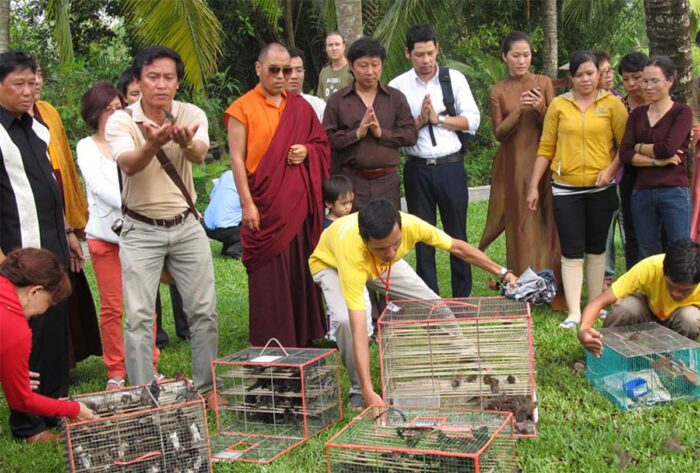
Life liberation in Vietnam (2010-2012).
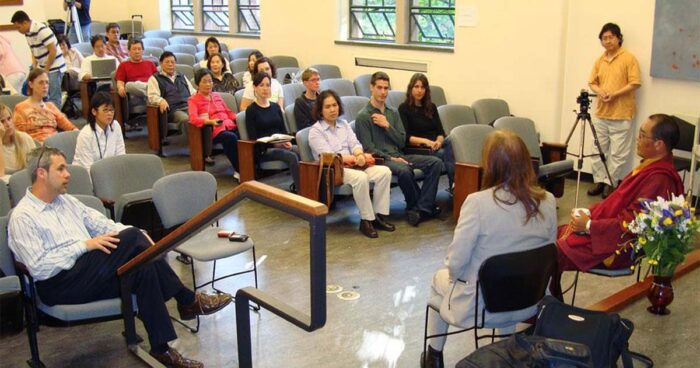
A teaching in Seattle (2007).

A religious congregation in Golog with Hungkar Dorje Rinpoche seated at the center (2013).

Hungkar Dorje with Vietnamese diaspora students in Toronto (2014).
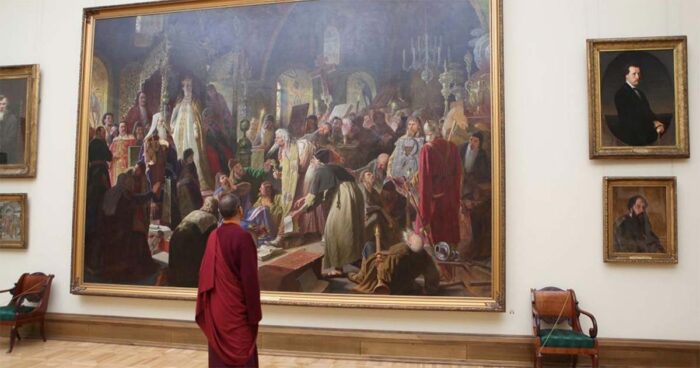
Hungkar Dorje appreciating an artwork during Moscow tour (2014).
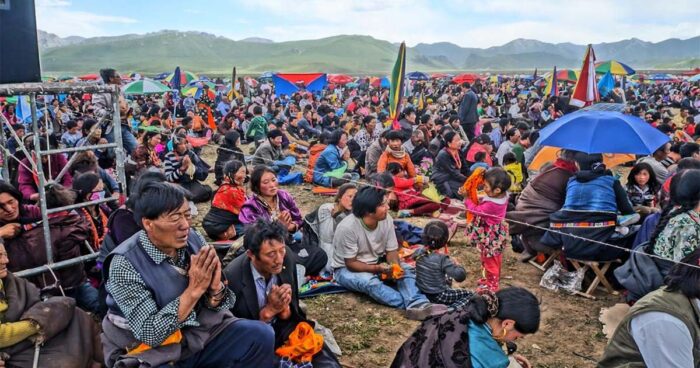
Tibetan students listening to Hungkar Dorje’s Kalachakra teachings in Golog, Tibet. (2014)
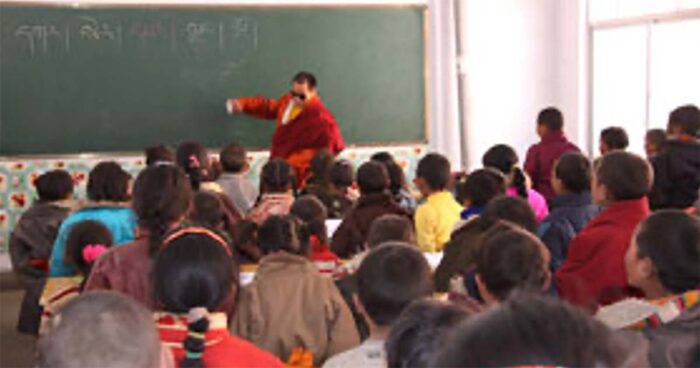
Hungkar Dorje teaches in a school built for the children of nomadic families. (undated photo)
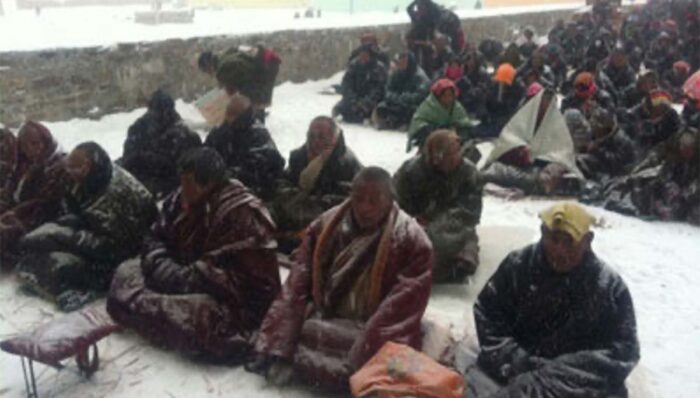
Tibetan devotees sit in the open amidst piercing winter cold in Golog to listen to their teacher Hungkar Dorje. (undated photo)

A large gathering of Tibetan devotees receiving Hungkar Dorje’s teachings on a pleasant day in Golog. (undated photo)
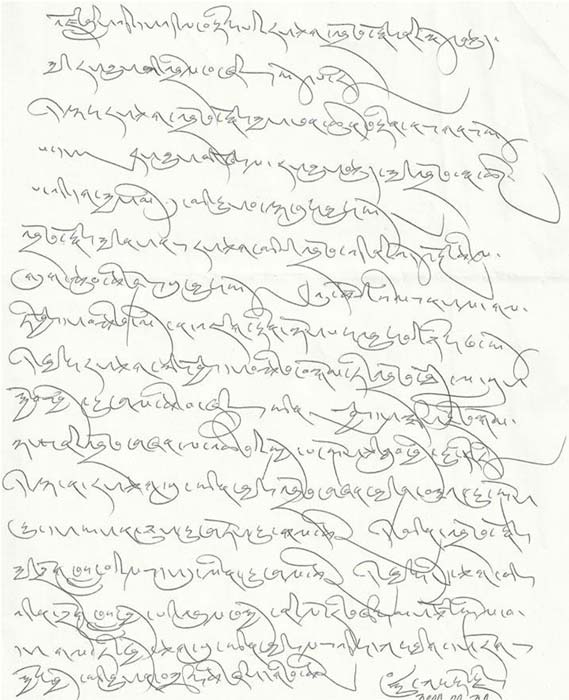
Hungkar Dorje Rinpoche’s appeal in Tibetan language for all to engage in life liberation practice in 2011.
Translation via HungkarDorje.org
Give up, as much as we can, causing harm to other beings!
All beings live in this world in dependence on each other with a natural interconnection between the environment and its inhabitants. There is a variety of naturally existing beings that must be able to live in this naturally existing world. From amongst all these beings humans have the greatest desire and are the most violent. If we do not have kindness and love in our minds there is the danger that we there will be no one left alive in this world. Therefore, it is important that we meditate on love and compassion and protect beings. Meditation on love and compassion means to give up, as much as we can, causing harm to other beings. Therefore, it’s important that everyone should give up eating meat or reduce how much they eat. Also, it is important to engage in the ransoming and release of animals. That is why with each year we are performing more and more animal releases.
I express my thanks to whoever performs this great good action of aiding and making donations so that this activity can be carried out.
Hungkar Dorje
21 November 2011